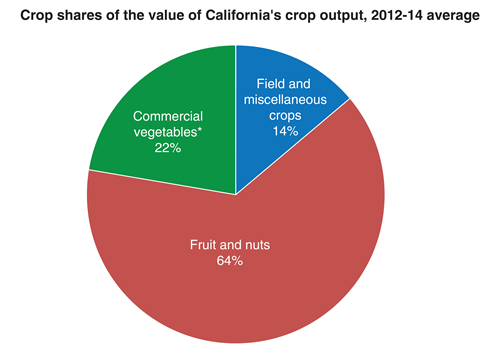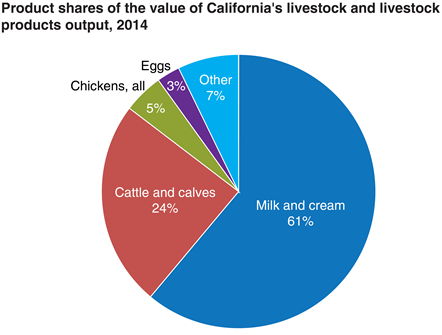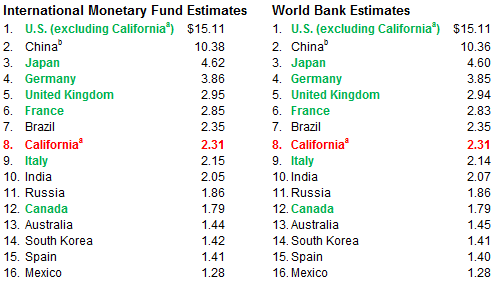Introduction
California is the third largest and the most populous region in the United States of America. This state holds an important social, economic, and political part not only in the US but also on a global scale. Therefore, this paper confirms the significance of California to the US and the global economies. It substantiates this position by exploring the social, political, and economic strengths and weaknesses of this state. To achieve this goal, this paper will illustrate the reasons behind its significance and factors that have led California to ascend to its status.
California’s Interstate Agriculture
According to the USDA report, California leads in farming among all states in the US. The main areas that California takes the lead include vegetable and fruit processing, bakeries, manufacturing of dairy products, and animal butchering. In not only agriculture, but California also takes the lead in the production of walnuts, almonds, dates, figs, kiwifruit, pistachios, pomegranates, grapes, and figs among other commodities that amount to 99% production nationwide.
Furthermore, the state has the capacity to produce 50% total value in melons and vegetables for the US. California is the leading state producer of almonds. The product forms the state’s principal export that generates an average net income of $3.4 billion annually. Figure 1 below shows the state’s farming statistics.

Its 80,500 farms yielded a product that generated close to $45 billion, which contributed to 11% of the US income. About 400, 000 people have secured jobs in these farms. This figure is averagely 2.6% of total California jobs. In addition, as shown in Figure 2, California is the leader in dairy production with more than 1, 500 farms and 1.8 million cows that generate close to $6.9 billion from milk and cream.

California’s Economy
Data from the Legislative Analyst’s Office Report ranked California’s economy in the eighth position in the world in 2014. It’s Gross Domestic Product (GDP) was the US $2.2 trillion. According to the World Bank data, as reflected in the Legislative Analyst’s Office Report, California’s economy is slightly smaller than that of Brazil, yet Brazil’s economy ranks seventh in the whole world, above Russia and even some of the industrial Group of Eight (G8) economies such as Italy and Canada. Figure 3 below shows this data.

Furthermore, statistical findings reveal that the GDP for California’s grew by 2.8% in 2014 to the level of outpacing that of the US, which only grew by 2.2%. In fact, California was ranked in the ninth position among states, only one pace behind Washington and Oklahoma. California’s economy has not been far from that of Washington since 1998 since it records a faster output growth compared to Washington. Its significant growth was accelerated at the period of the technology boom in the 1990s and that of the housing bubble experienced in the 2000s.
Predictably, the economy of California is expected to grow faster in 2016 to the level of surpassing that of Oklahoma by 5%. As presented in the 2013 Household Income Report by Noss, personal income is anticipated to grow by 3.6%. Salaries and wages will grow at 5.7%. As a result, the state will record a net of $60 billion, which is more than what it earned in 2015 as far as wages are concerned. Besides, California’s total employment will grow at above 1.9% from 2% that was witnessed in 2012.
The state’s economic growth influences the performance of other regions in the US. For instance, high economic growth in California relieves other states the burden of substandard living where a huge chunk of returns is used to boost developments such as infrastructure and health not only in the US but also around the world. This accomplishment reveals why California holds a central position that cannot be overlooked when discussing financial matters in America and any other country across the world.
In comparison with other states in the US, California’s income is widely spread and higher. The median annual earnings per family in California in 2014 were $60, 000 while those of the US, in general, were $52,000. California’s share of jobs in different sectors is at par and even higher in some areas compared to that of other regions in the US and the world. For example, California performs at par in areas such as health care, food and hotel service, construction, and retail and wholesale sectors. However, California’s is slightly higher in sectors such as local government and professional/business services and information.
The state of California’s level of significance in shaping the world in terms of its economic endowment is of great importance to the US and the world over. California is the only state that competes with its country in terms of the Gross Domestic Product. Since the US is perceived as the world superpower, any state such as California that has the capacity to shake America stands a better chance to be felt everywhere in the world. To the US, the state is among the leading contributors to its GDP, revenue, employment, and social amenities.
California’s Export around the World
International trade plays a significant role in California’s economy. Data of its international goods export reveals that it exported goods worth close to $30 billion in 2013 to the European Union, close to $25 billion each to China and Mexico, approximately $50 to Japan, South Korea, and Taiwan, and nearly $45 to other nations around the globe. According to the California Trade Report, “California accounted for 11.0% of the nation’s merchandise export trade in March.”
On export per product in US dollars, computers and electronics amounted to close to $50 billion while vehicles brought about $30 billion. While agriculture, foods, and beverages brought roughly $25 billion, chemicals and pharmaceuticals yielded $15 billion while other products brought close to $50 billion. On the global scale, nations depend on California in terms of exports such as farm produce, for instance, melons, vegetables, grapes, dates, kiwifruits, dairy products, and meat among others. The global digital industry depends on the state in terms of exports of computers and other digital gadgets.
California’s Rich Industrial Background
California enjoys a rich historical background. Its rich history ranges from its discovery in 1769, to being taken over by the US army after Mexico surrendered it, to James Marshal’s gold discovery in 1848 at Stutter Mill. According to the lecture notes, as presented by W. Seay, the world acknowledged the elaborate existence and economic strength of California during the Gold Rush era. This era revolutionized California’s economy, as well as its cultural, social, and political standing.
The discovery of gold in California led to a historic rapid change in technology that led to the abandonment of postmodernism and traditional ways of operation and political governance. For instance, Richard Nixon weighed the dollar against the gold. The sale of technological know-how became an area of global importance. Currently, nations seek technological knowledge exchange through the University of California and other learning institutions.
Scholars from all over the world come to harness technology in California as Havins confirms. These rapid change patterns spanned modernism, social upheavals, economic competition, and industrial revolution that led the US to clash with other nation-states around the globe. Industrial civilization exhibited at that time led to a speedy internationalization that enhanced California’s progress.
Extensive exertion of forces was evident in California because of the Gold Rush, which led to the first-world discovery of new technologies and improvement of the existing ones to be in line with the attained technological levels. Indeed, to date, California enjoys the legacy of Gold Rush from industries and cities that got a share of the gold cake and the new mining technology. Owing to this situation, lifestyles, material culture, and modernism that were experienced in California captured the attention of the whole world.
California spread its technological advancements to other US states and countries around the globe to the extent of attracting trade among nations from all over the world. Historical background confirms that archeological and geographical interests that the people of California had been neither traditional nor adapted, but arose from an inner force, which led to multiple discoveries and exploitation of natural resources that spread within the US and other nations, hence giving California a global significance. According to Fogo, California’s rich historical background and the archeological discoveries of gold stimulated the industrial revolution whose impact spread throughout the world.
Latino Argonaut’s invention of machines that could be used to mine gold led to improvements in machinery and tools that triggered technological advancement in the US and beyond. This detection made California among world leaders in the manufacture of quality high-tech machinery and tools for centuries. Its super-speed in technological progress was accompanied by the political and financial capability that placed the state in the international podium.
Entertainment
In terms of entertainment, California is a major leisure and tourism center that attracts people from all over the world. The state leads when it comes to the provision of television films, motion pictures, and other forms of entertainment. For instance, Burbank and Hollywood have gained preference from almost everywhere across the globe by producing issue-based films whose content cuts across world politics, economics, contemporary social issues, pipeline technologies, environment, and climate change among other areas. The industry has gained remarkable popularity, which is also used to market California in terms of its technology within and outside the US.
In terms of tourism, attraction sites such as Sea Wood, Disneyland, and glamorous entertainment city hubs such as Los-Angeles have captured the attention of the entire world. Natural beauty sceneries such as forests, national parks, giant sequoia Yosemite Falls, and nearly 900 miles of beaches along the Pacific Ocean have also had a share when it comes to positioning California in the world map. As Juarez and O’Mara confirm, California uses Burbank and Hollywood to do strategic marketing of its technological know-how, social systems, infrastructure, tourism destinations, entertainment, and the general US economic and political atmosphere.
Therefore, California has taken lead in proving its worth to the US and the world, a fact that has placed it in the limelight of global considerations and interests in areas trade, technological exchange, and relative political stability as well as stable social systems.
California’s Political Landscape
California adopted its first constitution in 1849. The constitution’s provisions for calling public officials, referendum, and public initiatives are emulative of world nations’ governance. The governorship is it’s the head executive branch that is electable for a four-year term. California also has a bicameral legislature that comprises 40 senatorial seats and 80 assembly members. It has a national political representation, two electable senate slots, and 53 council members who sit at the US Upper House. More importantly, it has 55 electoral votes.
Its political stance is balanced, thanks to the alternating Democrats and Republican governors such as George Deukemejian, a Republican, Jerry Brown, a Democrat, whose contribution in the field of politics has been felt everywhere in the world. The share of registered voters in 2010 was 43.4% Democrats and 44.5% Republicans. According to Bowler, Donovan, and Todd, in the early years, California was largely a Republican state. However, recently, it has experienced a trend where it is gradually assuming a democratic ground, especially in Los Angeles County and the Bay area.
Social Strength
Californian has the world’s oldest, largest, and strongest social welfare association, namely, the California Department of Social Services (CDSW). The state is represented at the national level to the Social Safety Net, which comprises institutions such as friendly societies that include universal healthcare, unemployment benefit homelessness shelters, and at times public transport subsidized services. The CDSW is under the docket of the California Health Human Services Agency.
It gets access to federal state funds that are used for assisting the disabled people, foster care, counseling family crisis, adoptions, and/or availing subsistence payments to poor families as a way of enhancing the welfare of children among other areas of social concern. Its focus goes beyond the US. This claim means that California’s goal of saving lives is felt globally. The Safety Net offers both long-term and short-term goals in social essentialities such as adequate access to food and employment. The assistance is given in the form of tax credits, nutritional support, and cash grants.
Millions of Californians and other people within and outside the US receive this assistance. For example, in 2014/2015, approximately 1.3 million individuals got monthly assistance from the CalWORKs program in cash for children. Another 4.3 million class of people received food cash benefits from Cal Fresh. These programs significantly contribute to poverty moderation. As from the beginning of 2016, the families that earn less than $14, 000 annually with children and those under $6,000 with no children are legible for a state Earned Income Tax Credit (EIATC), apart from the federal tax credits. All these incentives have the sole aim of easing the economic need of Californians and US residents at large.
Social, Economic, and Political Challenges
In recent years, the state legislature has not been able to resolve key problems, right from the problem of the water system to pension challenges. The state budget has not been approved in the schedule for years. The number of people who have not registered with one of the major political parties as voters has been increasing compared to other states. As a remedy, California has implemented reforms to deal with voter registration to resolve legislative issues. According to Smemo, the underlying issues have been witnessed because of disproportionate growth in spending, volatile revenues, inadequate infrastructures, and increasing debts.
California’s aging population is growing to the level of leaving only a few energetic individuals to sustain the workforce. Hence, state resources are being strained. Due to California’s concealed levels of transparency, civil engagement, and disclosures to the public, people lack enough information. The most critical challenges include uncertainty on revenue due to the hard-to-predict structures of tax and budgets, unreliable supply of water due to outdated water supply infrastructure, poor management of public retirement benefits that lead to people missing on payments, and the rise in health care costs coupled with reduced access to care.
Conclusion
California is a haven for social and political stability. It has established schemes to help poor people to access education, nutrition, and healthcare. Its infrastructure is of competitive standards internationally. The world television, motion pictures, and film industries are not left behind because the Hollywood film industry is a great income generator for almost all nations in the world. The tourist industry ranks California among the world’s best tourism destinations due to its large Pacific Ocean coast beaches, parks, forests, and waterfalls, not forgetting the glamorous city of Los Angeles that is among the world’s favorite vacation destinations.
In terms of social issues, California is emulated by other nations, for instance, its social organizations, social governance, and management of social unions and associations that are pragmatic when it comes to facilitating the social wellbeing of people and social self-reliance. Besides, the high rate of production and manufacturing has led to California being at the forefront in entering bilateral and multilateral trade pacts with nations. The export of machinery, farm produce, and technology on a global scale makes the state immensely important. Hence, as revealed in the paper, it suffices to declare California a state that holds a significant position not only in the US but also around the world.
Bibliography
Bowler, Shaun, Todd Donovan, and Caroline Tolbert. Citizens as legislators: Direct democracy in the United States. Ohio: The Ohio State University Press, 1998.
California Trade Report. Beacon Economics, London: Routledge, 2015.
Fogo, Brad. “The Making of California’s History-Social Science Standards: Enduring Decisions and Unsolved Issues.” History Teacher 48, no. 4 (2015): 738-775.
Havins, Nicole. “Technology industries helped post-Great Recession jobs grow faster in northern than in southern California.” Monthly Labor Review 1, no. 1, (2014): 1-9.
Juarez, Patty, and Paul O’Mara. “2015 Year in Review: California and Orange County Economic Growth.” Orange County Business Journal 39, no. 2, (2016): 1-2.
Legislative Analyst’s Office. 2015. California Economy & Taxes. Web.
Noss, Ammanda. Household Income Report: 2013. The US: The US Census Bureau, 2014.
Smemo, Kristoffer. “The Little People’s Century: Industrial Pluralism, Economic Development, and the Emergence of Liberal Republicanism in California, 1942-1946.” Journal of American History 101, no. 4 (2015): 1166-1189.
USDA. National Agriculture Statistics Service. Web.
W. Seay, The origins of political Economy, Virginia Commonwealth University, Spring 2016.